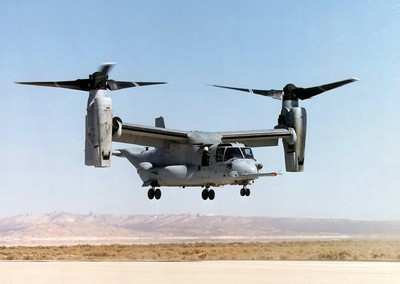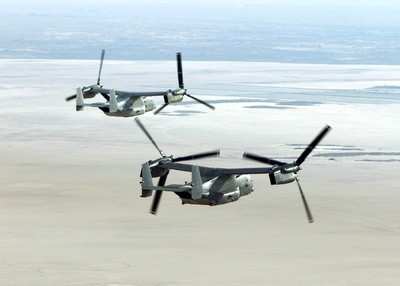No Fatalities When The V-22 Tilt-Rotor Went Down In Florida
An Air Force CV-22 Osprey assigned to the 1st Special Operations Wing went down at approximately 1845 EDT June 13 on the Eglin Range, north of Navarre, FL. Five crew members aboard the aircraft were taken to local area hospitals, but there were no reported fatalities.

The Air Force said in an official news release that two crew members were taken by ambulance, while the other three were taken via air. The extent of their injuries is unknown at this time. The mishap reportedly occurred during a routine training mission. A board of officials will convene to investigate the accident.
The 1st SOW mission focus is unconventional warfare: counter-terrorism, combat search and rescue, personnel recovery, psychological operations, aviation assistance to developing nations, "deep battlefield" resupply, interdiction and close air support. The wing has units located at Hurlburt Field and Eglin Air Force Bases in Florida, as well as Nellis Air Force Base, Nevada.
The wing's core missions include aerospace surface interface, agile combat support, combat aviation advisory operations, information operations, personnel recovery/recovery operations, precision aerospace fires, psychological operations dissemination, specialized aerospace mobility and specialized aerial refueling.
An Osprey attached to the unit went down April 9, 2010 near Qalat, Afghanistan that resulted three service personnel and a civillian being killed and and additional 16 injured. The pilot, flight engineer, an Army Ranger, and a civilian contract employee were killed in the crash.

In that accident, an Accident Investigation Board (AIB) said it could not determine the cause of the mishap by the standard of "clear and convincing evidence," in part because the flight incident recorder, the Vibration Structural Life and Engine Diagnostics control unit, and the right engine were destroyed and therefore not available for analysis. After an "exhaustive" investigation of the available evidence, the board president ruled out multiple possible causes. Items ruled out included loss due to enemy action, environmental brownout conditions and vortex ring state. In addition, a design problem that led to the replacement of the Central De-ice Distributor (CDD) support bracket found in all Marine Corps and Air Force Ospreys, was not a factor.
The board president determined 10 factors substantially contributed to the mishap. These included inadequate weather planning, a poorly executed low visibility approach, a tailwind, a challenging visual environment, the mishap crew's task saturation, the mishap copilot's distraction, the mishap copilot's negative transfer of a behavior learned in a previous aircraft, the mishap crew's pressing to accomplish their first combat mission of the deployment, an unanticipated high rate of descent and engine power loss. Substantially contributing factors play an important role in the mishap sequence of events and are supported by the greater weight of credible evidence. (USAF images from file)
 NTSB Final Report: Rutan Long-EZ
NTSB Final Report: Rutan Long-EZ ANN FAQ: Turn On Post Notifications
ANN FAQ: Turn On Post Notifications Classic Aero-TV: ICAS Perspectives - Advice for New Air Show Performers
Classic Aero-TV: ICAS Perspectives - Advice for New Air Show Performers ANN's Daily Aero-Linx (06.28.25)
ANN's Daily Aero-Linx (06.28.25) Aero-News: Quote of the Day (06.28.25)
Aero-News: Quote of the Day (06.28.25)




